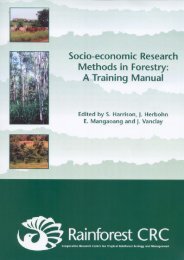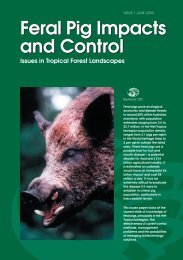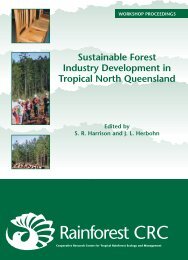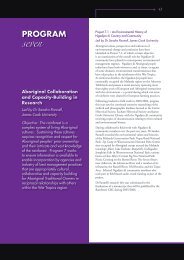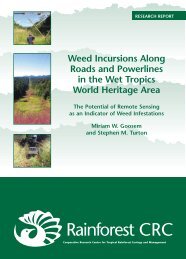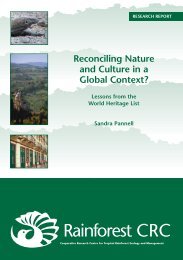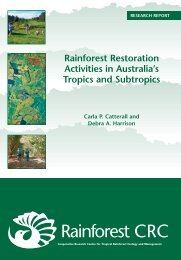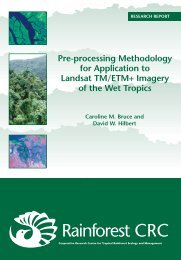Reconciling Nature and Culture in a Global Context? - Rainforest ...
Reconciling Nature and Culture in a Global Context? - Rainforest ...
Reconciling Nature and Culture in a Global Context? - Rainforest ...
You also want an ePaper? Increase the reach of your titles
YUMPU automatically turns print PDFs into web optimized ePapers that Google loves.
<strong>Reconcil<strong>in</strong>g</strong> <strong>Nature</strong> <strong>and</strong> <strong>Culture</strong> <strong>in</strong> a <strong>Global</strong> <strong>Context</strong>?Lessons from the World Heritage ListThe activities of villagers with<strong>in</strong> the Park are restricted to m<strong>in</strong>iscule areas of l<strong>and</strong> <strong>and</strong> seadesignated as part of the ‘traditional use zone’. In this zone the collection of firewood,harvest<strong>in</strong>g of traditional staple foods, such as sago from the gebang palm, captur<strong>in</strong>g legallyprotected species <strong>and</strong> “snakes, turtles, birds, dolph<strong>in</strong>s, whales, horses, deer or water buffalo”is strictly prohibited (PHKA <strong>and</strong> TNC 2000, Vol. 1: 46). Technology permitted <strong>in</strong> this zone isrestricted to “traditional tools” such as “machete, knife, sickle, pole, se<strong>in</strong>e net, hook, l<strong>in</strong>e, etc.”(ibid, Vol. 2: 141). Use of these tools is “licensed by the Head of Komodo National Park”(loc. cit.). Further regulated fish<strong>in</strong>g by the villagers is permitted <strong>in</strong> the ‘pelagic use zone’.Surround<strong>in</strong>g the complex system of zones <strong>in</strong> the National Park is a ‘limited take <strong>and</strong>utilisation’ buffer zone.Accord<strong>in</strong>g to an <strong>in</strong>formation sheet produced by The <strong>Nature</strong> Conservancy, the new zon<strong>in</strong>gsystem <strong>in</strong> Komodo National Park “allows for traditional use by Park <strong>in</strong>habitants while at thesame time the most valuable <strong>and</strong> sensitive locations are protected” (TNC n.d. e: 1). Whatconstitutes ‘traditional use’ by the villagers is based upon an eighteen-month survey ofmar<strong>in</strong>e resource utilisation recorded <strong>in</strong> the course of 38 ‘enforcement patrols’ with<strong>in</strong> the Park<strong>in</strong> the period 1996-1997 (TNC n.d. g; PHKA <strong>and</strong> TNC 2000; Bakar 1996). To date, noresearch has been undertaken regard<strong>in</strong>g the villagers’ ‘traditional use’ of terrestrial areas <strong>and</strong>resources. In view of the limited research <strong>in</strong>to the ‘socio-cultural conditions’ of the Park, fromthe po<strong>in</strong>t of view of ‘traditional use’ the zon<strong>in</strong>g system partitions the Park <strong>in</strong> a fairly arbitrarymanner. For local people, the new zon<strong>in</strong>g system transforms what is an <strong>in</strong>habitedenvironment <strong>in</strong>to a ‘dartboard’ of prist<strong>in</strong>e ‘natural’ areas, which not only limits or prohibitstheir future use <strong>and</strong> occupation but also gives priority to tourist access <strong>and</strong> use of the Park.As this last po<strong>in</strong>t suggests, these ‘dartboards of nature’ are “often constructed <strong>and</strong> overseenby non-residents whose livelihood is not dependent on the preserved environment” (Katz1998: 55). Indeed, <strong>in</strong> the management plan, tourism is depicted as an ‘eco-friendly’ activity<strong>and</strong> is associated with m<strong>in</strong>imal environmental impact, as opposed to the high impact,‘destructive’ practices of local people. Lock<strong>in</strong>g up biodiversity <strong>in</strong> a complex zon<strong>in</strong>g <strong>and</strong> buffersystem, it is clear that management of Komodo National Park is now focused uponpreserv<strong>in</strong>g nature outside of culture, or <strong>in</strong> spite of it. This last po<strong>in</strong>t is particularly apparentwith regards to the Park Authority’s official policy on immigration.Under the 2000 management plan, immigration <strong>in</strong>to Komodo National Park is strictlyprohibited. Contrary to local traditions where ‘immigrants’ <strong>and</strong> <strong>in</strong>-marry<strong>in</strong>g spouses acquiredusufruct rights, today marriage to a Park resident does not confer any settlement or userights with<strong>in</strong> the Park (PHKA <strong>and</strong> TNC 2000, Vol. 2: 148). In the same way that Parkrestrictions on terrestrial activities have placed greater pressure on mar<strong>in</strong>e resources,prohibit<strong>in</strong>g immigration has led to <strong>in</strong>creased human sedentarisation, aga<strong>in</strong> exacerbat<strong>in</strong>g the‘problems’ the plan seeks to ameliorate.In the Master Plan for the Park, immigration is seen as the source of the ‘exponential’population <strong>in</strong>crease <strong>and</strong> result<strong>in</strong>g human pressure upon the Park’s biodiversity. The “steady<strong>in</strong>flux of migrants <strong>in</strong>to the area” (PHKA <strong>and</strong> TNC 2000, Vol. 2: 64) is also held responsible forthe importation of destructive fish<strong>in</strong>g methods <strong>and</strong> modern external <strong>in</strong>fluences, such astelevision <strong>and</strong> radio, plus an <strong>in</strong>crease <strong>in</strong> associated ‘material wants’. Furthermore,immigration is directly l<strong>in</strong>ked to the loss of ‘traditional customs’, language <strong>and</strong> ethnic identity(ibid: 64-67). The 2000 management plan identifies “the majority of the people <strong>in</strong> <strong>and</strong> aroundKNP” as fishermen orig<strong>in</strong>ally from “Bima (Sumbawa), Manggarai, South Flores <strong>and</strong> SouthSulawesi” (ibid: 57). While the plan acknowledges that the Ata Modo are the “orig<strong>in</strong>al peopleof Komodo” (loc. cit.), it further states that “there are no pure blood people left <strong>and</strong> theirculture <strong>and</strong> language is slowly be<strong>in</strong>g <strong>in</strong>tegrated with the recent migrants” (loc. cit.). In herbook, ‘L<strong>and</strong> of the Komodo Dragon’, Claire Ellis goes so far as to state that “recentimmigration has swelled the population with<strong>in</strong> the [P]ark <strong>and</strong> virtually ext<strong>in</strong>guished the AtaModo” (1998: 77). It seems that for the people of Komodo no sooner had their culture come<strong>in</strong>to view then it was deemed to have disappeared. This notion of an ‘ext<strong>in</strong>guished’ people is35




